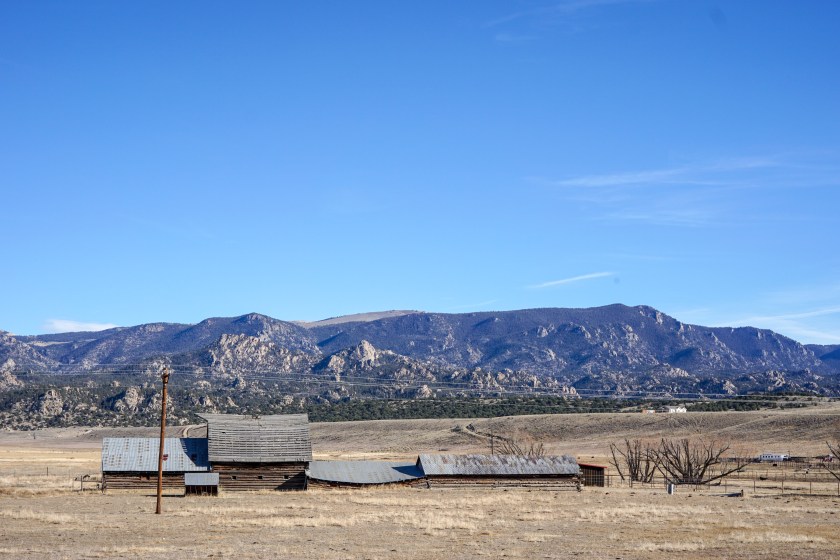Ever take a breathtaking photo of the clouds, only to find it marred by unsightly gray blobs when you pulled it up on the computer? Those are called “sensor spots,” and although they’re easy to get, they’re just as easy to combat.
Identify

Here’s a picture I took in the San Luis Valley in January. Look above one of the nubby peaks towards the right side of the photo. Is it a UFO? Unfortunately not; this is a sensor spot.
Sensor spots are caused by small pieces of debris sticking to the sensor of your camera. All modern cameras have built-in cleaning systems (usually vibrating the sensor to shake off particles to be caught in a safe reservoir, in the same way as a dog shakes off water), but sometimes that’s not enough.
The easiest way to test if you’ve got a sensor spot is to take a picture of a bright, cloudless sky. If one isn’t likely to appear soon, any brightly-lit, solid field of a light color should work. The spots are usually indistinguishable in a busy scene, but they’ll make themselves extremely obvious on a flat color.
Fix
There are a few different ways to address sensor spots.
- Large, lightly-adhered pieces of debris will fall off with a few pumps of air from a hurricane blower. Turn off your camera, remove the lens, turn it so the sensor is facing downwards (so that the debris can fall out of the camera), and squeeze. NEVER blow on your sensor using your mouth. No matter how dry you think your mouth is, the risk of a much worse problem (i.e., a glob of spit) is not worth it. If you’re visually inspecting your sensor for dust, remember that the lens inverts the image in both directions. If you are trying to remove a spot that’s appearing in the upper right of your image, it will be on the bottom left of your sensor.
- If a blower won’t cut it, you may need a full sensor cleaning. If you’re feeling brave and have a steady hand, there are a variety of cleaning supplies available (we have kits from Photosol and ProMaster, as well as individual components). Sensors are not as fragile as one might think—I actually did a successful swabbing of my first ILC, a Sony NEX-5, within a month of buying it—but a scratch or overdoing it somehow can be a death knell for the camera, so proceed with caution.
- Not comfortable doing it yourself? We at Mike’s Camera offer sensor cleaning services by our highly experienced repair technicians, so you needn’t worry. And if you’re in Colorado, you’re in luck—we’re offering FREE clean-&-check services at our Warehouse Clearance Tent Sales, this weekend in Boulder and the 18th-20th of May in Colorado Springs. First come, first served, so make haste!
- The photos that were already taken can be repaired as well. A quick touch with a content-aware healing tool or a carefully applied clone stamp will easily remove all trace of the spot. Photoshop & Lightroom are the major players in this category of software, but other solutions (some free!) like Affinity Photo, Corel PaintShop Pro, GIMP, Paint.Net, etc. will work just as effectively. And, of course, our Custom Imaging department would be happy to take on the job if you’d rather not have to bother with fixing a whole batch of photos.
Prevent
Dust is inevitable, but there are steps that can be taken to minimize the risk. Here are a few tips!
- Turn off your camera before changing the lens! A lot of the following tips are pretty self-evident, but a lot of people don’t know this one. While it’s powered on, the electricity flowing through the sensor creates a charge that can attract dust and adhere it in unwanted places.
- Change your lens as quickly as physically possible to minimize exposure of your sensor to the air.
- When your sensor is exposed, keep it in as shielded a place as possible (out of the wind, etc.) and keep the sensor pointed downward so as not to make the cavity a catch-all for anything floating down through the air.
- Fully weather-sealed lenses are not only safe in the rain, they will keep out dust as well. Prime lenses are also much less likely to admit dust than zoom lenses.
That’s all for today. I hope that many of you will be able to take advantage of the free cleanings this weekend and the next, and may your photography be dust-free!


I use a lens pen I have three different sizes and it works wonders